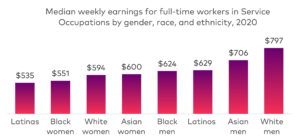Equal Pay Day, March 24th of this year, marks how many extra months women have to work to catch up with men’s earnings in the last calendar year. Full-time women workers made just 82 cents on the dollar compared to men at the median. The gap in annual earnings is even larger for Latinas who made just 55 cents, and Black women who made just 63 cents per dollar earned at the median for White non-Hispanic men. At the current rate of progress, it may take another 200 years for Latinas to reach pay equity with White men, and Black women more than 100 years.
This wage inequality is found both within occupations and between occupations. Service occupations are the lowest paid occupations for all groups. They include personal care workers, nursing care assistants, cashiers, child care workers– many of the occupations that have been recognized as essential during the COVID-19 pandemic. Black and Latina women are more likely than men of all races and White and Asian women to work in these low-wage occupations, a structural inequality which explains part of the wage gap. But Latinas and Black women also earn much less than men, particularly than White men, even within these low paid Service occupations. Latinas in Service occupations make 85.5 percent of what Latinos make, and just 67.1 percent of what White Non-Hispanic men make. For Black women, those numbers are 88.3 percent and 69.1 percent respectively.

From Elementary and Middle School Teachers and Nurses to Nursing Assistants, Maids, and Housekeepers: women earn less than men in each of the 20 most common occupations for women. The biggest gaps are for Financial Managers and First-Line Supervisors of Retail Sales Workers (gender earnings ratios of 66.1 percent and 74.7 percent respectively.) The same story plays out in the largest 20 industries for men. Occupational segregation is so substantial that four of the occupations which employ the most men (including carpenters and electricians) don’t even have enough women to report their numbers or wages— much has still to be done to get women into these often high-paying jobs in union construction trades.
Read the 2020 Occupational Wage Gap by Race and Ethnicity Report.


